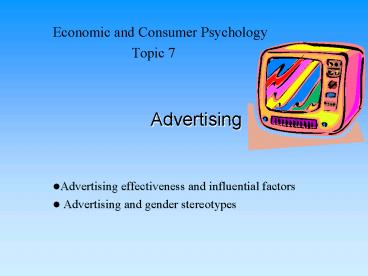Advertising PowerPoint PPT Presentation
1 / 12
Title: Advertising
1
Advertising
- Economic and Consumer Psychology
- Topic 7
- Advertising effectiveness and influential factors
- Advertising and gender stereotypes
2
Part 1. Which factors influence advertising
effectiveness?
- Features of adverts (some examples)
- placement, prime-time, repetition (e.g., Lodish
et al., 1995) - structure classical and vignette ad dramas
(e.g., Stern, 1994) - guilt appeal (e.g., Coulter Pinto, 1995)
- Information-processing approaches to persuasion
- central and peripheral processing
- personal involvement
- Psychological characteristics of audience
- congruence between ad contents and individuals
personality or attitudes - congruence between ad contents and aspects of
self-concept
3
Who prefers image and who prefers quality?
(Snyder DeBono, 1985)
- Appeals to product quality vs. appeals to images
- Social psychological construct of self-monitoring
- Three studies in which ads were experimentally
varied - e.g., Bottle of CC whisky resting on a set of
house blueprints - youre not just moving in, youre moving up or
- when it comes to great taste, everybody draws
the same conclusion - Study 1. Evaluative reactions (image-oriented
index 0-12) - whisky cigarettes coffee
- High SM 6.84 5.00 7.40
- Low SM 4.88 3.68 6.08
- Study 2. Consumer behaviour willingness to pay
( price, image first) - High SM 9.75/8.24 0.89/0.89 3.43/3.28
- Low SM 7.50/8.64 0.74/0.94 2.97/3.50
- Study 3. Willingness to consume product
(standardised index 1 to 1) - Image Quality
- High SM .7626 -.7008
- Low SM -.9106 .9201
4
Psychological factors of perceivers
- Related to self-concept
- Self-monitoring
- Style of self-presentation
- Congruency with self-concept
- Cultural differences in self-concept
- Individuals personal history and meaning-making
5
Advertising effectiveness
- Conceptualisation and measurement
- (Possible) hierarchy of effectiveness measures
- Memory
- Positive evaluation of advert
- Positive evaluation of advertised good/brand
- Buying intention
- If brand cost as much as your current brand, how
likely it is that you would buy this brand? - How much money would you be willing to spend on
this product? - How likely is that you will buy this product?
Next week? Next month? - Actual purchase
6
Part 2. Adverts and stereotyping
- Overwhelming proportion of literature on gender,
rather than race or other social categories - Do adverts reflect gender stereotypes?
- Do adverts help to perpetuate gender stereotypes?
- Contents of traditional gender stereotypes
- primary carer for children and household,
domestic work, soft, warm, subservient to needs
of others, dependent, sexy, beautiful - breadwinner, work outside domestic sphere,
professional, career, powerful, assertive,
authoritative, in control, independent, competent
7
Goffmans gender advertising
- Different emphasis and methodology
- Focus on analysis of postures and composition of
adverts and implied meanings - Examples
- superior and subordinate postures (e.g., relative
size) - openness and sexual invitation
- distant gaze and self-touching
- childlike expression
8
Content analyses of TV advertising
- Livingstone Green, 1986, UK, McArthur Resko,
1975, US - more quantitative approach
- category system for coding
- careful coding af advertisements with inter-rater
reliability - voice-overs as authoritative sources on product
are predominantly male - women mainly portrayed in domestic roles or
sexual roles, subservient to or dependent on
others
9
Empirical evidence relevant to perpetuation
argument
- Congruence in change over time
- Change in womens and mens actual roles
- Change in advertising
- From content analyses to audience impact
- Effects of advertising on adults
- Effects of advertising on children
10
Congruence in change over time
- 1950s to 1980s greater participation of women in
workforce, more managerial and professional
careers - comparative study of TV commercials (e.g., Allan
Coltrane, 1996) - Replication of Goffmans gender advertisements
(Kang, 1997) - 28 year gap, similar methodology and categories
of analysis - some changes, but comparatively small
- more unclad bodies
- More recent changes?
- Men in advertising
- Gender role critique in adverts?
11
Influence of TV ads on children
- TV exposure and gender-role endorsement
- Children who watched 25 hours of TV per week
accepted gender stereotypes as more accurate
images of reality than children who watched lt10
hours (Freuh McGhee,1975) - Gender-related content of adverts and career
aspirations - Ads showing women role models in non-traditional
vs. traditional occupations had systematic impact
on girls reported career aspirations
12
Influence of TV ads on womens self-confidence
and behaviour(Jennings, Geis Brown, 1980)
- Portrayal of women restricts their interests to
sexual and domestic concerns ? implies lack of
competence and confidence in public domains of
career and achievement - Current TV ads depress womens self-confidence
and independence of judgement, whereas
counter-stereotypical ads should raise them - Exposure to two sets of ads, followed by public
speaking and Asch-type conformity situation - Independence of judgement Self-confidence
- Trad ads 1.98 2.73
- Reversed ads 2.49 3.38

